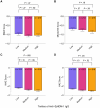Association of Antibodies to Helminth Defense Molecule 1 With Inflammation, Organomegaly, and Decreased Nutritional Status in Schistosomiasis Japonica
- PMID: 38942608
- PMCID: PMC11481327
- DOI: 10.1093/infdis/jiae330
Association of Antibodies to Helminth Defense Molecule 1 With Inflammation, Organomegaly, and Decreased Nutritional Status in Schistosomiasis Japonica
Abstract
Immunomodulation enhances parasite fitness by reducing inflammation-induced morbidity in the mammalian host, as well as by attenuating parasite-targeting immune responses. Using a whole-proteome differential screening method, we identified Schistosoma japonicum helminth defense molecule 1 (SjHDM-1) as a target of antibodies expressed by S. japonicum-resistant but not S. japonicum-susceptible individuals. In a longitudinal cohort study (n = 644) conducted in a S. japonicum-endemic region of the Philippines, antibody levels to SjHDM-1 did not predict resistance to reinfection but were associated with increased measures of inflammation. Individuals with high levels of anti-SjHDM-1 immunoglobulin G had higher levels of C-reactive protein than those with low anti-SjHDM-1. High anti-SjHDM-1 immunoglobulin G responses were also associated with reduced biomarkers of nutritional status (albumin), as well as decreased anthropometric measures of nutritional status (weight-for-age and height-for-age z scores) and increased measures of hepatomegaly. Our results suggest that anti-SjHDM-1 responses inhibit the immunomodulatory function of SjHDM-1, resulting in increased morbidity rates.
Keywords: Schistosoma japonicum; helminth defense molecule; inflammation; malnutrition; organomegaly.
© The Author(s) 2024. Published by Oxford University Press on behalf of Infectious Diseases Society of America. All rights reserved. For commercial re-use, please contact reprints@oup.com for reprints and translation rights for reprints. All other permissions can be obtained through our RightsLink service via the Permissions link on the article page on our site—for further information please contact journals.permissions@oup.com.
Conflict of interest statement
Potential conflicts of interest. All authors: No reported conflicts. All authors have submitted the ICMJE Form for Disclosure of Potential Conflicts of Interest. Conflicts that the editors consider relevant to the content of the manuscript have been disclosed.
Figures






References
-
- McManus DP, Dunne DW, Sacko M, Utzinger J, Vennervald BJ, Zhou XN. Schistosomiasis. Nat Rev Dis Primers 2018; 4:13. - PubMed
-
- Pearce EJ, MacDonald AS. The immunobiology of schistosomiasis. Nat Rev Immunol 2002; 2:499–511. - PubMed
-
- GBD 2016 DALYs and HALE Collaborators . Global, regional, and national disability-adjusted life-years (DALYs) for 333 diseases and injuries and healthy life expectancy (HALE) for 195 countries and territories, 1990–2016: a systematic analysis for the global burden of disease study 2016. Lancet 2017; 390:1260–344. - PMC - PubMed
MeSH terms
Substances
Grants and funding
LinkOut - more resources
Full Text Sources
Research Materials

